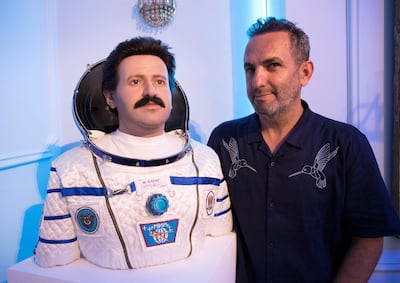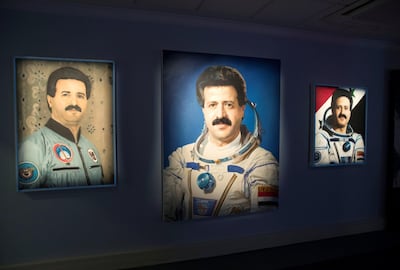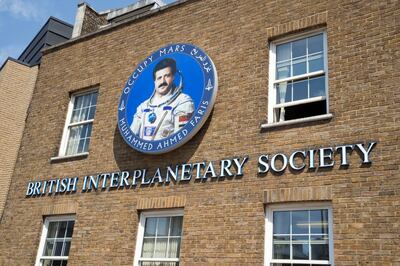Life on Mars is not the obvious solution to a Syrian refugee crisis that has seen millions flee their homeland since 2011.
However, Space Refugee, a thought-provoking multimedia installation by Turkish artist Halil Altindere, explores that premise very effectively.
Based on Altindere's friendship with Muhammed Ahmed Faris, the only Syrian to go to space, the challenge in the artwork is to imagine at the extreme how refugees could build new lives if the world doesn't react to their plight. "I say to people: 'If you don't want the refugees here, then send them to Mars when they can be pioneers and live their lives there,'" Altindere says before Space Refugee's London opening last Saturday night.
The star of the full-scale exhibition in central London, is Faris, 67, a cosmonaut who travelled to the Mir space station in 1987. He was the first and only man from the country – and the second Arab – to travel into space.
Later an air force commander, he defected from Syria in 2012. He fled rather than face orders to turn weapons on the country's own people as the regime of President Bashar Al Assad attempted to blast its way to survival, and now resides in Turkey.
The irony of exile remains that Faris was a hero of the country, with schools, airports and roads named after him.

Visitors to the exhibition will be able to view life-size silicon representations of the pioneer. There are spacesuits and mementoes from Faris' time with the space programme of the Soviet Union. A series of portraits, such as Muhammed Ahmed Faris with Friends, capture the Syrian with his fellow crew. There is also a painting of the cosmonaut with his wife and two children, who are also in exile.
Altindere had the inspiration for the work while on a visit to Berlin at the height of the refugee crisis. He returned to Istanbul and sought out Faris for a chat. The two men agreed to work together on a collaboration for a documentary that features fictionalised scenes of Syrian spacemen setting up a Mars colony. It was filmed in Turkish region Cappadocia.
Life on space - with dignity
Perhaps the most stunning aspect of the installation is Journey to Mars, a four-minute virtual-reality experience of the imagined colony and the movements of the Syrian spacemen around the red planet. The Cappadocia vista serves as plausible substitutes for Mars, as three astronauts in space suits adorned with Syrian badges explore the deserts and ravines. A space ranger vehicle named Palmyra has been made by the team.

One person who will not experience the exhibit in the British capital is Faris himself. "He cannot leave Turkey as a result of his status," Altindere says. "This is the reality that he travels through the documentary."
In the film, Faris talks about his experience of space, with a message of hope for Earth. He speaks to Turkish schoolchildren at an Istanbul planetarium, and fellow Syrian refugees. "I hope we can rebuild cities for them in space, where there is freedom and dignity and where there is no tyranny, no injustice," he says.
The lessons he learnt from his time in space shape his perspective on earthly troubles. "Those seven days, 23 hours and five minutes changed my life," Faris told The Guardian in 2016. "When you have seen the whole world through your window, there is no us and them, no politics."
Space Refugee has proved popular around the world, and the work has already travelled to various countries, including a spell in UAE at the Sharjah Planetarium. One of the London exhibition's supporters is the Sharjah Art Foundation.
After opening on Saturday as part of the third annual Art Night, Space Refugee will be on show until Sunday in the headquarters of the British Interplanetary Society, a venerable institution founded in 1933 that is dedicated to the cause of space exploration.
It makes for a perfect match-up. A huge backlit medallion of Faris has been mounted on the building, which overlooks the busy train lines leading to Waterloo station from the south-west. The BIS has contributed their models of spacecraft and a raft of historical items it holds from the US and Soviet space programmes.
Altindere's documentary features contributions made by Nasa staff and experts in space law, who were interviewed via Skype to explore the practicalities of setting up on Mars.
A Berlin architectural company was commissioned to provide drawings of the underground buildings in the space colony. These include Arabian-inspired geometric designs.
Nasa has contributed a light box that is designed to grow plants in space. Altindere is pleased with the sprouting leaves. "Just a week ago, we dropped a few seeds in these space garden containers and now look at how they spreading out," he says.

With all the angst on Earth over the millions displaced by the Syrian civil war, it is not hard to feel a pang of hope from the provoking ideas presented by Space Refugee.
_____________
Read More
NYUAD's Ways of Seeing exhibition seeks to challenge your views of art
Salvator Mundi: World's most expensive painting to go on display at Louvre Abu Dhabi in September
New curators and artists announced for 10th Abu Dhabi Art
_____________



